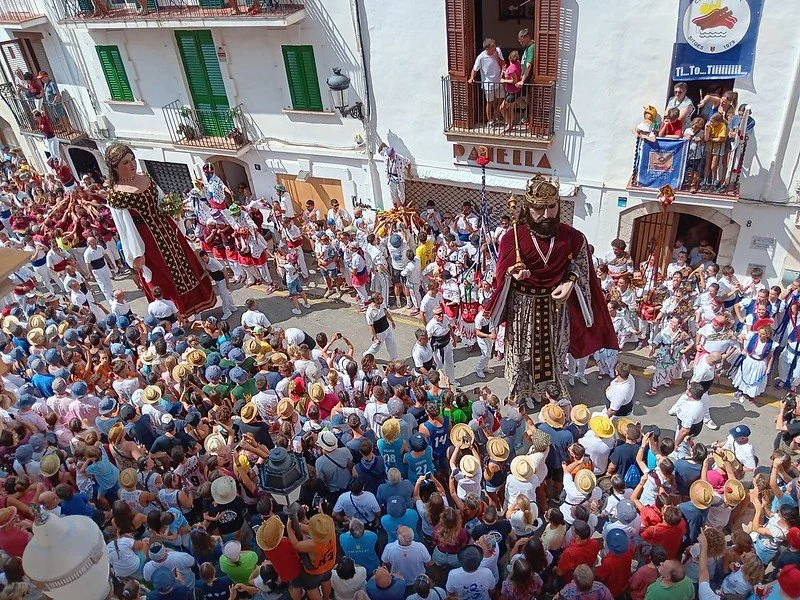A Brief History of Festa Major
The explosive heart of Sitges
If you’ve ever been in Sitges in late August, you’ve probably felt it, you know… that sudden shift in the air when the town pulses with energy, colour, and kaboom — fireworks that shake your bones and warm your heart. This is Festa Major, Sitges’ most beloved and fiery celebration. And it’s not just a party — it’s a deep-rooted tradition with centuries of history, joy, and fierce local pride.
Where it all began
The Festa Major de Sitges honours the town’s patron saint, Sant Bartomeu (St. Bartholomew), with celebrations traditionally held on August 23rd and 24th. The origins of the festival date back to the 17th century, when local religious and civic authorities began organising formal celebrations in honour of the saint. Over the years, what started as a solemn religious occasion grew into a bold, joyful expression of community — full of music, dance, fire, and folklore.
It’s the kind of party where ancient meets adrenaline. And Sitgetans wouldn’t have it any other way.
There are actually two Festa Majors, not one! Sant Bartomeu is the big one (!) and Santa Tecla, his sister saint is on September 22-23 typically. Although slighty smaller still features diables, fireworks, and traditional dances.
Saints, saints, and explosions
While the roots are spiritual, Festa Major is anything but quiet. Yes, there’s a solemn procession that carries the image of Sant Bartomeu through the old town, but it’s flanked by a glorious chaos of gegants (giant figures), diables (devils with pitchforks and fireworks), castellers (human towers), and grallers (piercing traditional flutes) that echo through the narrow streets.
And then there’s La Nit de Foc — the Night of Fire — when devils dance through smoke and sparks in the Correfoc, a fire run that turns the town into something between a medieval dream and a pyromaniac’s fairytale. It’s exhilarating, a little terrifying, and utterly unforgettable.
The Gegants (Giants)
These larger-than-life papier-mâché figures — representing kings, queens, nobles, and historical characters — have danced through Sitges since the 1800s. Each has a name and personality, and the local kids know them well. They’re often accompanied by capgrossos (big-headed figures) who add playfulness to the parade.
Correfoc
The Correfoc (literally, “fire run”) is not for the faint of heart. Local diables wear fireproof suits and masks while shooting off handheld fireworks in the narrow streets. Brave participants dance underneath the sparks, usually dressed in long sleeves and hats to avoid burns.
Castellers are literal Human Towers
This Catalan tradition is a jaw-dropping mix of balance, bravery, and community. Teams (colles) create human towers up to nine people high, with children (la enxaneta) climbing to the top to raise a hand in triumph. It’s a UNESCO-recognised cultural treasure.
A festival of the people
What makes Festa Major so special is how deeply it belongs to Sitges. It’s not a tourist show (though plenty of visitors watch in awe) — it’s a festival of the people, organised by local collas (neighbourhood groups and cultural associations) who have passed down dances, costumes, and traditions for generations.
Children learn to dance the Moixiganga (a symbolic representation of the Passion of Christ), teens train to become castellers, and whole families help decorate balconies, bake traditional sweets, and prepare for long nights of revelry. The pride is tangible. This isn’t just about the past — it’s about keeping it alive.
Traditional Catalan music played on gralles (shrill wooden flutes) and tabals (drums) forms the heartbeat of Festa Major. But as night falls, the local bars and beach parties crank up the beats. The party often doesn’t stop until sunrise.
More than a celebration
For locals, Festa Major is a time to reconnect — with each other, with their history, and with the soul of Sitges itself. It's loud and chaotic, yes, but it’s also profoundly meaningful. A yearly ritual that says We are still here, this is our town and this is our story.
And for anyone lucky enough to be swept up in it, it’s a celebration that leaves a mark — in your heart, on your clothes (thanks, fire run sparks), and in your memory forever.
Thinking of visiting?
If you find yourself in Sitges in late August, don’t just watch Festa Major. Feel it. Join the crowd on the seafront as the fireworks explode over the church, dance under the sparks with the devils, cheer on the castellers as they defy gravity. It’s not just a party — it’s a love letter to a town that knows how to celebrate life, heritage, and each other.
Because in Sitges, the past is not something in a museum — it’s dancing in the streets and keeping historic stories alive.
You can read our interview with the President of the Festa Major Committee and he had some fascinating things to tell us, especially about how they are striving to become more and more sustainable each year.


















